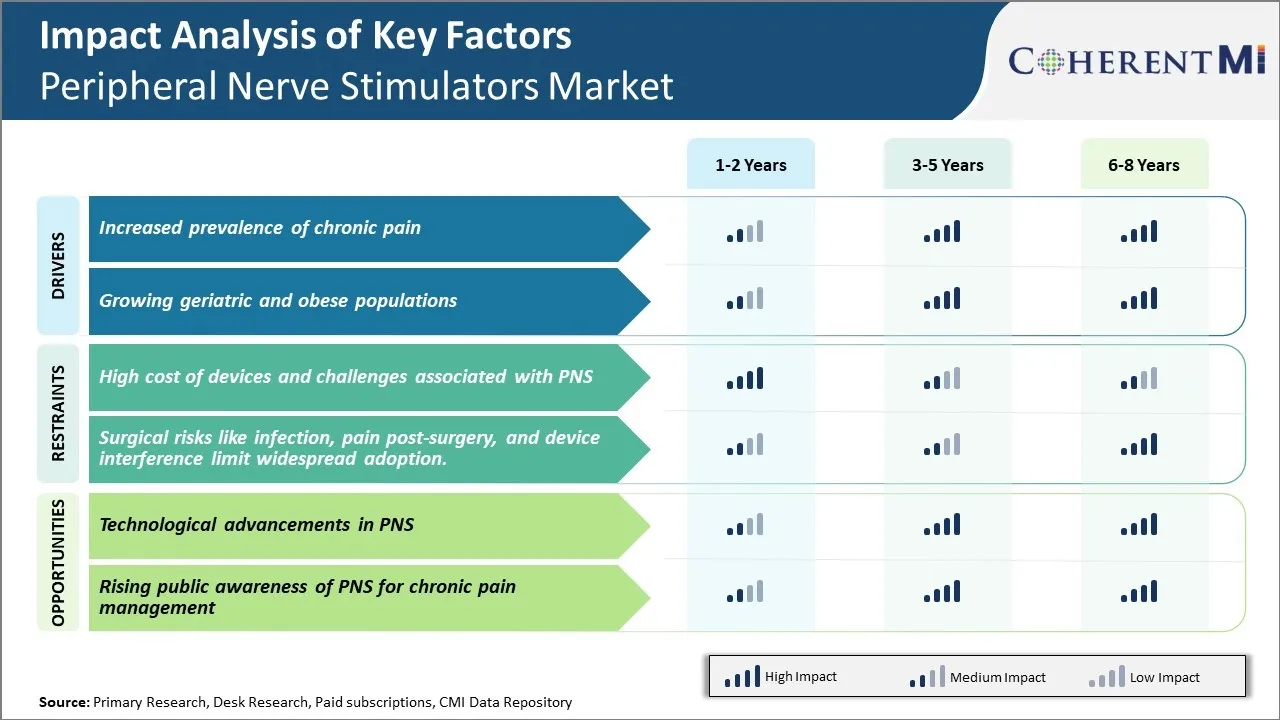Peripheral Nerve Stimulators Market Trends
Market Driver - Increased prevalence of chronic pain
Chronic pain affects millions of people worldwide and can significantly diminish quality of life. It is often associated with conditions like arthritis, diabetes, cancer, and back injuries. As life expectancies continue rising across populations, cases of chronic pain will likely rise proportionately due to higher rates of age-related health issues. Peripheral nerve stimulators are gaining acceptance as a treatment option for patients whose pain cannot be managed by medication alone.
Chronic pain not only causes ongoing discomfort but can also lead to depression and interfere with normal daily activities and sleep. Traditional medication-based approaches often come with unwanted side effects and may stop working overtime as the body develops tolerance. Peripheral nerve stimulation offers an alternative by delivering mild electric pulses to nerves near the spinal cord or limbs. This disrupts the transmission of pain signals to the brain and induces pleasant sensations that can lessen pain severity. The treatment is minimally invasive compared to other options and allows dosages to be adjusted as needed.
Patients are increasingly willing to consider peripheral nerve stimulation since it provides effective long-term relief without drugs. The treatment option is suitable for joints, limbs, and areas of the body impacted by various pain conditions. It especially benefits those seeking non-narcotic solutions or who need ongoing therapy to maintain quality of life. Growing awareness of this solution as a mainstream treatment choice will likely expand its provider base and uptake. As chronic pain prevalence increases, peripheral nerve stimulators can play an important role in pain management as a preferred choice over or alongside pharmacological approaches.
Market Opportunity - Growing geriatric and obese populations
Age and weight-related health issues contribute significantly to chronic pain conditions. There are more older citizens globally now than ever before, and advanced age often brings ailments like arthritis that cause debilitating joint and back pain. Obesity is also a rising epidemic worldwide, with excess weight stressing the body in ways that can trigger chronic pain over time. Peripheral nerve stimulators see growing demand from these demographics.
For geriatric patients especially, effective long-term pain relief is a high priority. They want options allowing an active lifestyle without disruptions from discomfort. Traditional pain therapies may present more risks for the elderly or have inconvenient dosage schedules. Minimally invasive nerve stimulation provides an attractive solution, with outcomes often on par or superior to drug-based approaches. Hospital visits or complex usage requirements are replaced with simple remote-controlled treatment at home. This independence matches the priorities of most older consumers.
Rising rates of obesity similarly imply growing numbers of individuals at risk of pain arising from weight-related issues like diabetes or musculoskeletal problems. Peripheral stimulators can make lifestyle modification programs for weight loss more achievable by addressing underlying soreness. Their ability to safely deliver long-lasting relief empowers more obese patients to stick with dietary changes or exercise routines that might otherwise exacerbate pain levels. As these demographics continue expanding sharply, corresponding needs for effective treatment will proportionately increase the appeal of peripheral nerve stimulation technology.

Market Challenge - High cost of devices and challenges associated with PNS
One of the major challenges currently impeding the growth of the peripheral nerve stimulators market is the high cost of peripheral nerve stimulation devices. These devices are expensive to manufacture due to the intricate electrical components and sophisticated programming features required. The costs are then passed on to patients, as peripheral nerve stimulators are not always covered by insurance and Medicare reimbursement policies vary greatly between different providers. This financial barrier prevents many patients from accessing this treatment option. In addition, proper placement of PNS leads requires a minimally invasive surgical procedure to be performed by a skilled physician, further adding to the overall cost of treatment and putting it out of reach for price-sensitive patients and healthcare systems. Training physicians to implant these devices also takes significant resources. With healthcare budgets under intense pressure globally, high treatment expenditures associated with PNS pose a significant challenge to its acceptance and uptake.
Market Opportunity - Technological advancements in PNS for market opportunity
Technological advancements have the potential to open up significant growth opportunities for the peripheral nerve stimulators market. Continuous improvements are being made to develop less invasive and more user-friendly PNS systems. Miniaturized, wireless and injectable PNS devices are some concepts being explored, which could help drive down costs of the technology as well as simplify the surgical implantation process. There is also scope for more sophisticated programming options that could allow for tailored, responsive stimulation parameters according to changing patient needs. Cloud-based programming capabilities may help improve remote monitoring and management of PNS therapy as well. As new innovations enhance the effectiveness and ease of use of PNS while lowering its resource requirements, its acceptance for treating various chronic pain conditions is likely to improve greatly. This could translate into expansion of approved clinical indications and adoption rates in the coming years.